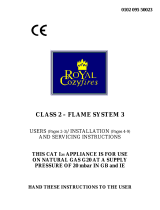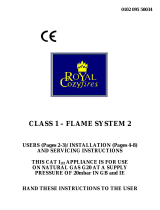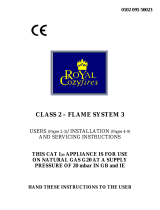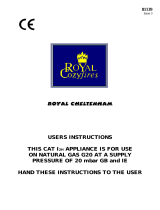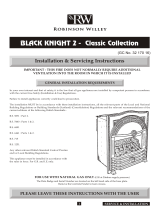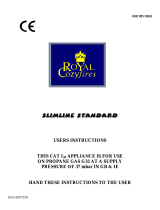Page is loading ...

0102 095 50621
7+(52<$/%8&.,1*+$0
USERS INSTRUCTIONS
THIS CAT I
2H
APPLIANCE IS FOR USE
ON NATURAL GAS G20 AT A SUPPLY
PRESSURE OF 20 mbar IN GB & IE
HAND THESE INSTRUCTIONS TO THE USER

DESCRIPTION
This Royal Cozy Fires Decorative Fuel Effect gas fire has been developed to give a realistic coal burning
appearance with the convenience of gas. The fire is complemented with an attractive detachable Marblesque
Frame. The appliance has been designed to enable it to be installed into most applications where the warmth and
comfort of an open fire, with a high radiant heat is required. This appliance is intended for decorative purposes, the
coal bed uses ceramic simulated (coals), to give a realistic appearance and constructed to allow secondary air to be
entrained into the bed to ensure clean combustion. An aerated twin ported steel burner is used, running parallel
across the front of the fire. A single gas control with a variable high to low setting is used with a Flame
Supervision Device (FSD) fitted to ensure that should the pilot flame be extinguished for any reason, (including
turning off the appliance) the gas supply to the burner is cut off until a full lighting sequence is repeated. A
separate Piezo igniter is used to ignite an oxy-pilot sensor (ODS) which will cause the appliance to (shut off) in the
event of continued spillage occurring under hazardous or blocked flue conditions. The fire bed consists of ceramic
fibre components and coals all of that are removable for cleaning purposes when required. It is important when
relaying the coal bed and coals to follow the instructions correctly.
TECHNICAL DATA
TYPE OF GAS G20 only. Decorative Marblesque Frame Details
SETTING PRESSURE 20 mbar +1- mbar (cold) Temperature Rated class O (100
O
C Maximum
GAS INPUTS (GROSS) Max 6.6 kW (22520 Btu/h) Front, Fret & Canopy, Cast Iron.
Min. 3.8 kW (13000 Btu/h) Spacer frame, Sheet metal,
Pilot 0.26 kW (890 Btu/h) Finished High temperature black paint.
IMPORTANT NOTES
This appliance is intended for decorative purposes, designed and manufactured to the requirements of the British Standards
Institution BS 5258 Part 12 1990 and is for use on natural gas only.
All gas appliance installations must be carried out by a competent person in accordance with the Gas Safety (Installation and
Use) Regulations or the rules in force and in accordance with the manufacturers Installation Instructions. Failure to comply
could lead to prosecution.
The chimney or flue (unless new) must be swept prior to installation. It is recommended that the appliance is serviced
annually by a competent person and the flue checked for satisfactory clearance of products and that there is no excessive
build up of soot. The curing effect of heating the coals will cause an initial odour which, although not harmful, may require
additional ventilation until the odour has disappeared. Additional purpose built ventilation is not required for this appliance in
GB only. For IE, ventilation is required with a minimum cross sectional area of l00sq. Cms and should be checked regularly
to ensure that it is free from obstruction.
The appliance has a naked flame, a fireguard conforming to B56539 or B56778 should be used for the protection of the very
young, elderly and infirm. Combustible materials should not be put on, or left in the hearth nor should the coal bed be used to
burn rubbish or other materials.
Care must be taken on the selection of wall coverings within close proximity of the fire as some vinyls and embossed
materials may become discoloured by convected heat. Soft furnishings must be kept clear from the radiant heat of the fire and
from impinging of the hearth area. The hearth must not be covered by combustible materials such as carpets etc.
This product uses fuel effect pieces, gaskets and insulation material containing Refractory Ceramic Fibre (RCF), which are
man-made vitreous silicate fibres. Excessive exposure to these materials may cause temporary irritation to eyes, skin and
respiratory tract, consequently, it makes sense to take care when handling these articles to ensure that the release of dust is
kept to a minimum.
This appliance is fitted with an Oxy-pilot which in the event of the flue being blocked, or hazardous conditions causing the
appliance to spill products of combustion, will shut "OFF" the gas supply to the appliance. If the sequence is repeated the
appliance must be turned ’Off ’and not used until expert advice has been obtained or the cause established and rectified.
- 2 -

Clearance to Side
Minimum clearance required to any combustible material to the side of the appliance must be l50mm.
Clearance to Shelves
Minimum clearance to the underside of a l50mm combustible shelf from the hearth must be 790mm, add 12.5mm
to this dimension for every 25mm increase in the depth of the shelf.
To light The Appliance
Remove the Fret (controls cover) to gain access. Press and turn the gas control knob anticlockwise until the
indicator dot is opposite the IGN. Keep the gas control knob fully depressed.
Press and release the piezo igniter until the pilot flame situated on the left-hand (see Fig 2) side of the burner has lit
at both ports. Keep the gas control depressed for a further 10 to 15 seconds.
Release the gas control and check that the pilot flame remains lit. Note: For convenience, the unit can be operated
with the pilot only, i.e. with the control knob set in the IGN position. In the event of igniter failure a match or taper
can light the pilot, place at the pilot position and depress the gas control.
Push in the gas control slightly and turn anti-clockwise so that the indicator dot is at the required setting. Replace
the fret (controls cover).
To turn off the appliance and pilot, turn the gas control clockwise from any position until the indicator dot is
opposite OFF
IMPORTANT: After turning off or if the pilot and the appliance goes out for any reason, wait for three minutes
before attempting to relight.
- 3 -

Dismantling the Fire Bed for Cleaning
Allow the fire bed to cool for 1 hour before handling any components.
Should any soot accumulation become excessive, the fuel effect pieces should be removed from the fire for
cleaning. Cleaning should be carried out in a well-ventilated area or in the open air, by gently brushing with the
pieces held away from your face so that you avoid inhaling the dust. We do not recommend the use of a normal
domestic vacuum cleaner, which may blow dust back into the air.
Remove the coals, lift off the simulated coal front, and remove the two Tee shaped burner inserts together with the
coal support shelf. Take out the lower fire back and side cheeks. Once all the fibre components have been removed
from the firebed check that debris has not fallen or lodged in the burner slots (both front and rear). If debris is
present it may be easily removed by using a small piece of thin cardboard to ease out any foreign matter. Be sure to
remove the cardboard after use. Any sooty deposit on the thermocouple can be cleaned off using a non-fluffy cloth.
It is very important that the coals and the coal bed components are laid as shown no extra coals or material
may be used. If any of the items become lost or damaged, replacements must be obtained before further use
of the appliance.
Relaying the Firebed
Place the L & R hand side cheeks with the rebated edges on the sides of the burner support frame and push towards
the back. Place the lower fibre back on the support flange of the back plate and locate the L & R coal support
shelves over the support channel of the burner frame. Place the two Tee shaped burner inserts in the channel
between the front and rear burner ports, locate the fibre coal front on the shelf above the facia panel. See Fig. 2.
- 4 -

Coal Lay-out
Position 4 large coals with their rear edge located on the burner inserts and the front on the coal front - rotate
slightly as shown in Fig 3.
Place 4 large coals against the coal support shelf and over the three centre spaces of the front row of coals. Place 4
large coals vertically on the triangular sections of the coal support shelf as shown in Fig 4.
- 5 -

- 6 -
Sectional View of firebed
(without small coals laid)
Place the eight small coals
randomly and in a stable
position between the large
coals.

Cleaning the Front of the Appliance
The fire must be turned off and allowed to cool. The paintwork should be cleaned with a soft cloth or soapy water.
Cleaning the Marblesque Surround
To clean the Marblesque frame, use a damp cloth and allow to dry. Do not use abrasive polishes etc. In the event of
any damage occurring to the finish the frame it can be removed by removing by lifting vertically. Care must be
taken to avoid any damage being caused to the frame or the appliance. To refit, lift it up a couple of inches from
the hearth and lower it onto the fixing bracket. See the Installation Instructions for more detail.
Spares and Service
For spares and service contact your local supplier, installer or direct to the manufacturer stating the appliance and
the serial number from the data label located on the facia panel.
Advantage should be taken of regular servicing and inspection of gas appliances to ensure their continued safe
operation.
Short Parts List
Description Qty Crosslee Part No.
Coal Support Shelves L & R 1 42394
Burner Inserts 2 41345
Front Simulated Coal 1 40481
L. & R. Hand Side Cheeks 1 41981
Set of Coals 1 42395
Fibre Back Panel Top 1 41979
Fibre Back Panel Bottom 1 41929
Marblesque Frame 1 42121
MAXIMUM HEAT INPUT
6.6 kW 22520 Btu/h (GROSS)
Royal Cozyfires are manufactured by:
CROSSLEE plc
Aber Park Industrial Estate,
Aber Road, Flint, Flintshire. CH6 5EX
Spares Tel 01422 203963
Fax: 01422 204475
Service (GSA Ltd.) 01703 516611
Customer Service 01422 200660
Fax 01422 206304
*Technical Help Line 0906 8633268
*Calls charged at 50p per minute
- 7 -

0102 095 50631
7+(52<$/%8&.,1*+$0
INSTALLATION & SERVICING INSTRUCTIONS
THIS CAT I
2H
APPLIANCE IS FOR USE
ON NATURAL GAS G20 AT A SUPPLY
PRESSURE OF 20 mbar IN GB & IE
HAND THESE INSTRUCTIONS TO THE USER

DESCRIPTION
This Royal Cozy Fires Decorative Fuel Effect gas fire has been developed to give a realistic coal burning
appearance with the convenience of gas. The fire is complemented with an attractive marblesque frame. The
appliance has been constructed to enable it to be installed in most applications, where the warmth and comfort of an
open fire and a high radiant heat is required. This appliance is intended for decorative purposes, the coal bed uses
ceramic simulated (coals) to give a realistic appearance and also to allow secondary air to be entrained into the bed
that will ensure clean combustion. An aerated twin ported steel burner is used, running parallel across the front of
the fire. A single gas control with a variable high to low setting is also used combined with a Flame Supervision
Device (FSD). This is fitted to ensure that should the pilot become extinguished for any reason, (including turning
off the appliance) the gas supply to the burner is cut-off until a full lighting sequence is repeated. A separate Piezo
Igniter is used to ignite an Oxy/pilot sensor (ODS) which will cause the appliance to (shut off) in the event of
continued spillage occurring under hazardous or blocked flue conditions. The fire bed consists of ceramic fibre
components and coals all of that are removable for cleaning purposes when required. It is important when relaying
the coal bed and coals to follow the instructions correctly.
This appliance is suitable for installation into the following flues:
7" minimum diameter flues (CLASS I)
5" minimum diameter flues (CLASS 2)
Pre-Cast flues to BS 1289 Pt. I 1986.
The installation must always be used in conjunction with a suitable hearth surround- (refer to page 5 for further
details).
TECHNICAL DATA
Overall height of Marblesque frame = 696mm
Overall height of appliance without frame = 605mm
Overall width of frame = 680mm
Overall width of appliance without frame = 470mm
Minimum height of opening required = 540mm
Maximum height of opening required = 590mm
Minimum width of opening required = 405mm
Maximum width of opening with spacer = 470mm
Forward projection from opening (with fret) = 165mm
Minimum depth of opening required see figs 1,2 & 3.
(See Page 18 for overall dimensions Figs. 20 & 17).
TYPE OF GAS G20 Only
Supply Pressure 20 mbar +1-1 mbar (Cold)
GAS INPUTS (Gross)
Max. 6.6 kW (22520 Btu/h)
Min. 3.8 kW (13000 Btu/h)
Pilot 0.26kw (890 Btu/h)
Main Injector Type Stereomatic 046/19/196/76M
Pilot OP Oxy/Pilot NO 9022
GAS CONNECTION 8mm OD Tube
WEIGHT (Two Packs) 17.5kg and 23.5kg
Decorative Marblesque Frame Details Temperature rated - Class O (100
O
C) Maximum
Front Fret and Canopy - cast Iron, Painted Black.
Installation Regulation and Requirements
The appliance must be installed by a competent person in accordance with the current Gas Safety (Installation and
use) Regulations, the rules in fence and in accordance with the manufacturer’s instructions, failure to do so could
lead to prosecution.
- 2 -

The following relevant Codes of Practice and British Standards:
The Building Regulations issued by the Department of the Environment.
The Building Standards (Scotland) (Consolidation) Regulations issued by the Scottish Development Department.
BS 8303 1986 BS 5440 Pt. 1 1990 & Pt. 2 1989
BS 1251 1987 BS 5871 Pt. 2 1991 & Pt. 3 1991
BS 6891 1988 BS 6461 Pt. 1 1984
BS 715 1989 BS 1289 Pt. 1 1986
BS 7566 Pts. 1-4 1992
Important Notes
Areas of this appliance will become hot after prolonged running and it is recommended that for the protection of
the very young, elderly and infirm a fireguard conforming to BS 6539 or BS 6778 be used.
Care should be taken to prevent any damage being caused to surrounding soft furnishings or decor e.g. many
embossed vinyl wall coverings may become discoloured if located too close to the appliance Clearances required
for combustible shelves are shown in Fig 1.
Care should be taken to ensure that when the appliance is installed into a Pre-cast flue, the chimneybreast is lined to
prevent the plaster etc., cracking through any excessive flue gas temperatures.
A hearth must always be provided to project forward from the rear of the frame a minimum of 350mm and a
minimum of 150mm either side of the fire opening.
The hearth must be a minimum thickness of l2mm with a perimeter height of 50mm to deter combustible materials,
carpets etc. being placed on the hearth.
The area under the firebox must have a minimum non-combustible thickness of 25mm.
In most installations a back panel will be required, this will also need a minimum fire resistance rating of Class O
(l00
O
C).
Additional purpose built ventilation is not required for this appliance in GB only for IE ventilation is required with
a minimal cross sectional area of 100 sq. Cms and should be checked regularly to ensure that it is free from
obstruction.
The chimney or flue (unless new) must be swept before installation. It should be checked annually for spillage
(smoke test) when the appliance is serviced and that there is no excessive build up of soot.
Check that the chimney and flue structure are sound and conform to the following flue requirements:
a) A conventional brick or stone chimney with a minimum effective cross sectional dimension of 225 x 225mm. A
lined flue with a minimum diameter of l75mm having a chairbrick and throat forming lintel conforming to BS 1251
or a builders opening measuring 540mm high x 400mm - wide with a sufficient depth for debris collection. If a
chairbrick is fitted, a minimum depth requirement for the fire is shown in Fig 1, if this depth is not available, the
chairbrick will have to be removed.
b) A twin walled metal flue box manufactured to BS 715 with a twin walled l25mm diameter flue and a minimum
effective height of 3 metres. See Fig 2.
C) A pre-cast flue to BS 1289 Pt 1 l986 and BS 1289 1975 including properly constructed precast flues with a cross
sectional area of 13000 sq. mm.
Important
Dampers, register plates or incorrect flue terminals, must not restrict the above flues. The flue must service a single
appliance and not have any branches or traps that may impede the natural draught. Any flue damper plate or
restrictors shall be removed or fixed in the fully opened position.
The front and base of the fire opening must be flat and square to ensure a good seal with the appliance; this is to
ensure that there is no reduction in draught through the fire that may cause spillage to occur.
- 3 -

Contents Check List
Fire Box Assembly-c/w Burner Assembly Coal Pack Including;
Lower Fibre Back 11 Medium Strata Coals
L& R Hand Side Cheeks 8 Small Strata Coals
Simulated Coal front
Burner Inserts
Coal Support Shelf
Spacer Frame Assy.
Spacer frame Fixing Kit
Fitting Kit: - 7" (175mm.) & 5" (125mm.) Spigot Restrictors
Screws & rawl Plugs, Fixing Straps, and self-tap screws
3 x Lengths of Bundy pipe
Installation and Servicing Instructions
Users instructions
Fire Surround and Opening Requirements
7" Diameter Flue, Chairbrick and Builders opening (Class I). See Fig 1.
5" Diameter Flue and Metal Flue Box (Class 2). See Fig 2.
Precast Flues. See Fig 3.
Clearance to side (timber surrounds etc.)
Minimum clearance required to any combustible material to the side of the appliance must be 150mm.
Clearance to Shelves
Minimum clearance to the underside of a l50mm deep combustible shelf from the hearth must be 790mm.
Add 12.5mrn to this clearance for every 25mm increase in depth of shelf.
- 4 -
Depth A is to be a
minimum of l50mm from
the knee to the front face
of the surround to satisfy
the debris collection
requirement.
Depth B is nominally
70mm.
If no chairbrick is fitted,
the minimum d1stance
required between the rear
of the opening and the
rear of the frame is
220mm.

Installation using a 5" Diameter Metal Flue Box.
Important: The spigot restrictor marked B’ must be fitted See Fig. 4
When the metal flue box is to be built-in as a false chimneybreast using timber studwork with
plasterboard facing, the metal flue box should be enveloped with insulation material such as rockwool or
similar to prevent a build-up of heat within the structure. Either an air gap of 75mm should be maintained
between any combustible materials and any part of the metal flue box or a minimum of 25rmm of
insulation material between the metal flue box and the combustible material.
It is important that both the back panel and the appliance are sealed to the metal flue box to prevent any
leakage of flue products or reduction in the flue draught.
- 5 -

- 6 -

Installation of the Appliance
Check that the chimney conforms to the required specifications as previously stated. Examine the
condition and carry out any remedial work as necessary, if the flue has been used for solid fuel it should
be swept and a smoke test carried out to check that satisfactory smoke clearance has been established. If
all the smoke is not drawn into the flue, pre-heat the flue with a blowtorch or similar and recheck. If there
is any uncertainty examine for the cause and if necessary seek expert advice.
Gas Supply
BEFORE COMMENCING WORK, TURN OFF ANY APPLIANCES THAT ARE FED BY THE
METER AND ISOLATE THE GAS SUPPLY BY TURNING OFF AT THE METER.
The gas connection to this appliance is made with 8mm o/d rigid or semi-rigid tube to a pressure test
elbow situated on the LH side of the burner as shown in fig. 11. It is advisable to provide a means of
isolating the gas supply to the appliance for servicing with either a restrictor elbow or isolation cock such
as shown below. Provision is made i.e. knockout blanks for entry into the box in both L & R hand rear
corners and at the L & R hand sides. Any pipe used under the tray must be in rigid tube such as bundy. 3
pieces of bundy are included in the fixing kit to assist the installer (a) a short piece for use with a
restrictor elbow (b) an elbow for connection with an isolation cock and (c) a short formed section for
connecting to the supply using the inline connector supplied.
The installer is reminded of the requirements of BS 6891 1988 dealing with enclosed pipes. The Standard
requires that when a gas pipe is fed through a wall, the pipe should be enclosed in a tight sleeve to protect
against failure caused by movement and shall be constructed to prevent passage of gas either between the
pipe and sleeve or sleeve and wall.
Where a gas supply pipe enters the box in any of the positions stated, the hole around the pipe should be
sealed with a silicone sealant or similar to prevent ingress of air into the flue. Permanent sealant e.g. fire
cement etc. should not be used as these would prevent removal of the firebox if so required. Where a
connection is to be made direct on to the gas control the pipe support bracket can be removed by
unscrewing the control mounting nut and sliding the support bracket over the control spindle and
replacing the nut.
Dismantling the fire prior to Installing
It will be necessary to dismantle the burner from the firebox before installing the box in the opening.
To remove the burner, unscrew the two screws at the base of the burner fascia panel and pull forward,
observe that the feet of the rear legs locate in two formed tags in the base panel.
If the installation has either a 5in (125mm) or 7in. (175mm) flue it will be necessary to select the
appropriate restrictor. To insert the correct restrictor plate remove the centre screw securing the fibre
retaining strip in position and slacken off the two outer screws to allow the two slots in the restrictor plate
to slide behind the two screw heads. Replace the centre screw and tighten the Outer screws- See Fig. 4.
- 7 -

Important
THE RESTRICTOR PLATES MARKED ’A’ AND ’B MUST NOT BE USED WITH PRE-CAST
FLUES.
The restrictor marked A is for use with 7in. (175mm) diameter flues and the restrictor marked ’B’ is for
use with sin. (l25mm) diameter flues.
The appliance is supplied without any Flue Restrictor fitted in position i.e. suitable for pre-cast flues.
Installing the Spacer Frame and Vent Box
Before installing the appliance protect the hearth from scratches and damage that could occur during the
installation.
With the gas supply pipe routed and laid to the position required, the surround or back panel must be
fitted and sealed to the chimney to prevent any seepage of flue products or any ingress of air into the flue
from anywhere other than the flue outlet of the fire. The spacer frame must be fitted end sealed to the
back panel or the opening, and the vent box screwed to the spacer frame. Either of the following methods
are recommended- See Fig. 5 on the next page.
a 6 holes are provided in the rear of the spacer frame with access through the front of the frame, for
applications where it is convenient to use this method of fixing. Only 4 fixing positions are required,
at the bottom of each leg and 2 others in either the top of the left or right hand lags or the top cross
member.
b. Where it is not suitable or desirable to drill or deface the back panel, an alternate method is to secure
the spacer frame to the inside or the opening.
• For 16 in openings, holes are provided on the inside flanges of the spacer frame to attach the
fixing straps using the self-tap screws provided.
• For 18in openings, bend the required tags inward to attach the fixing straps.
- 8 -

Locate and screw the vent box to the spacer frame with two 8 x ¾ self-tapping screws at the top and two
M4 Taptite screws at the bottom, ensuring that a good seal exists with the back panel. Complete the gas
supply to the location of the burner connecting elbow and place the burner into the vent box locating the
feet of the rear legs into the two tags in the base. Secure into position with the 2 No.8 self-tap screws
supplied and complete the gas connection using either a restrictor elbow or isolating cock.
Select the correct restrictor plate for the type of flue being used:
Restrictor A for 9 x 9in. 7in (l75mm) diameter and over or
Restrictor B for 5in (l25mm) diameter flues
No Restrictor is to be used with Pre-cast flues
Note: The complete installation should be tested for Gas soundness
Locate the inner frame complete with the canopy and fire front, over the tag formed in the top flange of
the box, ensuring
that the legs are central with the edges of the box. The frame is screwed to the lower
legs with the screws provided. See Fig 7.
The Marblesque surround is supported on a bracket screwed to the top member of the spacer frame, this
has a limited amount of adjustment to enable the rear of the frame to fit flush with the back panel.
Locate the Marblesque frame in position by gently lowering the frame centrally over the inner frame
engaging the teeth of the top brackets over the supporting bracket.
- 9 -

- 10 -

Laying the Coal Bed
Place the L & R hand side cheeks with the rebated edges on the sides of the burner support frame and
push towards the back. Place the lower fibre back on the support flange of the back plate and locate the L
& R coal support shelves over the support channel of the burner frame. Place the two Tee shaped burner
inserts in the channel between the front and rear burner ports locate the fibre coal front on the shelf above
the fascia panel.
Coal Layout
Position 4 rectangular coals with their rear edges located on the burner inserts and rotate slightly as shown
in Fig 10.
Stand 3 large coals vertically ever the centre three spaces of the front row of coals and place 4 large coals
vertically on the triangular sections of the coal support shelf, as shown in Fig. 11.
Place the 8 small coals randomly and in a stable position between the peaks of the larger coals.
- 11 -

- 12 -

Checking Operation of Fine
Turn on the gas supply at the meter and to the appliance at the isolating cock. Purge the air to the
appliance. Rotate the control knob to the ignition position, depress the control and push the piezo to ignite
the pilot. Check that the electrode is sparking to the tip of the thermocouple and continue until a pilot
ignition is established. Depress the control knob slightly and rotate anti-clockwise until the index symbol
is aligned with the small flame symbol on the indicator label. Release and rotate the control knob to the
high position (large flame symbol) and check that the flame picture is satisfactory prior to carrying out the
spillage test.
To check the gas pressure at the appliance, allow the coals and coal bed to cool and turn off the gas
supply at the isolating cock. Remove the hexagon headed screw and connect a manometer to the pressure
test point, turn on the gas and ignite the fire allow to heat up and check that the gas pressure is 20+/-1
mbar- any appreciable drop may indicate losses through the pipework. The pressure test point may also be
used to check for leakage of the joints to the appliance. Allow the coal bed to cool before replacing the
screw.
Turn the gas control to the OFF position, wait for 90 seconds, fully depress the gas control, turn to the
ignition position and release the control. Attempt to light the pilot with an already prepared match or
taper, if the pilot lights the FSD is faulty.
Spillage Check
Light the appliance and set to the maximum input, locate the front and fret in position and leave to warm
up for 5 minutes. Check for satisfactory clearance of combustion products by positioning a lighted smoke
match in the centre of the fire opening, 200mm below the canopy and level with the rear edge of the front
simulated coal. See fig. 14. All the smoke must be drawn into the flue, if spillage occurs, allow a further
10 minutes. Should spillage still occur, disconnect the appliance and examine the chimney for the fault
and rectify- The test should be repeated if an extractor fan is situated in the room, if there is a connected
room, the test should be repeated with all the doors in that room opened.
Demonstrate the lighting and extinguishing procedures to the user
Advise that:
The curing effect of heating the coals will cause an initial odour which, although not harmful, may require
additional ventilation until the odour has disappeared.
Any debris or soot is cleaned from the appliance. Advise the customer that they should read their Users
Instructions before operating the fire and always follow the advice in the section headed ‘Removal of
Debris or Soot Deposits’. The appliance must be serviced annually by a competent person in accordance
with these instructions and the appliance is checked for spillage in accordance with the method detailed in
these instructions.
- 13 -
/
